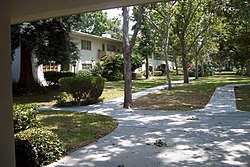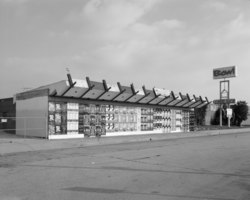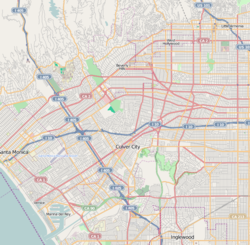Crenshaw, Los Angeles: Difference between revisions
→Notable places: Copy edit. |
Adding See also. |
||
| Line 1: | Line 1: | ||
{{See also|Baldwin Hills/Crenshaw, Los Angeles}} |
|||
{{Refimprove|date=January 2013}} |
{{Refimprove|date=January 2013}} |
||
{{Use dmy dates|date=July 2017}} |
{{Use dmy dates|date=July 2017}} |
||
Revision as of 23:36, 16 October 2017
This article needs additional citations for verification. (January 2013) |
Crenshaw | |
|---|---|
| Coordinates: 34°01′05″N 118°20′26″W / 34.01810°N 118.34064°W | |
| Country | |
| State | |
| County | |
| Time zone | Pacific |
| Zip Code | 90008 |
| Area code | 323 |
Crenshaw, (CREN-shaugh)sometimes referred to as The 'Shaw [1] or the Crenshaw District, is a neighborhood in the southwestern region of Los Angeles, California. The name derives from Crenshaw Boulevard, one of the city's major thoroughfares.
The Crenshaw commercial business corridor along this street has had many different cultural backgrounds throughout the years but still has a positive African American commerce with many other ethnicity groups in recent years.[2]
Geography
According to Google Maps,[3] the Crenshaw neighborhood is centered on Crenshaw Boulevard and Buckingham Road. The neighborhood of Baldwin Hills is to the south, Baldwin Village is to the west, and Leimert Park is to the east.
Education
Public schools are operated by the Los Angeles Unified School District (LAUSD).
- Crenshaw High School, which is south of Martin Luther King Boulevard and east of Crenshaw Boulevard, is the local public high school.
The district's charter schools in the area include the KIPP network. KIPP Academy of Opportunity[4] middle school, Celerity Nascent Charter School[5] the New Design Charter School (built in 2004), View Park Preparatory High School,[6] and View Park Preparatory Middle School.[7]
Government
Post office
The United States Postal Service operates the Crenshaw Post Office and the Julian Dixon Station.[8]
Emergency service
The Los Angeles Fire Department operates one main fire station - Station 94
Neighborhood
This section needs additional citations for verification. (December 2016) |
Crenshaw is a largely residential neighborhood of single-story houses, bungalows and low-rise condominiums and apartments. There are also commercial buildings with an industrial corridor along Jefferson Boulevard. There are also several other commercial districts throughout the neighborhood.
After courts ruled segregation covenants to be unconstitutional, the area opened up to other races. A large Japanese American settlement ensued, which can still be found along Coliseum Street, east and west of Crenshaw Boulevard.[9] African Americans started migrating to the district in the mid 1960s, and by the early 1970s later were the majority.[10]
In the 1970s, Crenshaw, Leimert Park and neighboring areas together had formed one of the largest African-American communities in the western United States. Crenshaw had suffered significant damage from both the 1992 Los Angeles riots and the 1994 Northridge earthquake but was able to rebound in the late 2000s with the help of redevelopment.
In 2006, the population of Crenshaw was around 27,600. Currently, there is a huge demographic shift increased in where many middle and lower-class blacks and Latinos are migrating to cities in the Inland Empire as well as cities in the Antelope Valley sections of Southern California as a form of gentrification.[11] Despite the current major demographic shift, blacks had maintained their status as one of the neighborhood's largest ethnic group, with African-Americans forming 63.34% of the population, followed by Whites and Latinos (any race) at 30%, white (not Latino), 16.89%; Asian, 4.38%; American Indians, 0.43%; Native Hawaiian and other Pacific Islanders, 0.20%; other races, 9.20%; two or more races, 9.32%.
Transportation
The Metro Crenshaw LAX Line is an 8.5-mile light rail line that will "add eight new stations serving the Crenshaw neighborhood, Leimert Park, Inglewood, Westchester and surrounding areas". [12]
The line will run between the Expo/Crenshaw station and Aviation/96 Street station, transiting generally north-south along Crenshaw Boulevard.[13]
Notable places


- Baldwin Hills Crenshaw Plaza shopping mall is a landmark. It was home to a tri-level Wal-Mart (formerly a Broadway department store, then later a JJ Newberry's), Sears and Macy's. Additional retail stores later were purchased by the mall such as Victoria's Secret, Forever 21, and Ashley Stewart, as well as office supply stores such as Staples.
- Marlton Square, formerly known as Santa Barbara Plaza, was a shopping center. The center had aged over the years and was a failed redevelopment project.[14] Local city business developers and Kaiser Permanente purchased the land and demolished the old retail stores in 2011. A new Kaiser Permanente medical office building was built on the site.[citation needed]
- The Crenshaw Square center and sign, a local landmark, had been in some disrepair throughout the years. In 2007, the sign was replaced by a modern illuminated red-and-green sign. The Crenshaw Square outdoor shopping center was sold in 2015 and underwent a significant renovation in 2016.
- The West Angeles Church of God in Christ, a Baptist church near the intersection of Crenshaw and Exposition boulevards, is home to Bishop Charles E. Blake.
Los Angeles Historic-Cultural Monuments
- Village Green is a neighborhood near Baldwin Hills. It is Los Angeles Historic-Cultural Monument #174.
- The Holiday Bowl was a bowling alley and cafe known for being a center of ethnic diversity during the 1960s and 1970s. It featured a sushi bar known as the Sakiba Lounge with live musical acts. Its historic Modernist Googie architecture style has been refurbished by the buildings new tenants, Starbucks and Walgreens, along with a newly outdoor shopping center that opened in early 2006. It is City of Los Angeles Historic Cultural Monument #688.[15][16]
Media
Literature
The novel Southland, by Nina Revoyr, is set in the Crenshaw neighborhood.[17]
Special events
- The annual Kingdom Day Parade: The 2013 parade was the 30th edition of the Parade. It is usually broadcast in the LA area on KABC-TV.[18] The parade goes west on Martin Luther King Jr. Boulevard to Crenshaw Boulevard.
- The Taste of Soul Festival takes place every October (since 2005).
Demographics
In the post-World War II era, a Japanese-American community was established in Crenshaw. There was an area Japanese school called Dai-Ichi Gakuen. Due to a shared sense of being discriminated against, many of the Japanese-Americans had close relationships with the African-American community.[9]
At its peak, it was one of the largest Japanese-American settlements in California, with about 8,000 residents around 1970, and Dai-Ichi Gakuen had a peak of 700 students.[9]
Beginning in the 1970s the Japanese American community began decreasing in size and Japanese-American businesses began leaving. Scott Shibya Brown stated that "some say" the effect was a "belated response" to the 1965 Watts riots and that "several residents say a wave of anti-Japanese-American sentiment began cropping up in the area, prompting further departures."[9] Eighty-two-year-old Jimmy Jike was quoted in the Los Angeles Times in 1993, stating that it was mainly because the residents' children, after attending universities, moved away.[9] By 1980, there were 4,000 Japanese ethnic residents, half of the previous size.[9] By 1990 there were 2,500 Japanese-Americans, mostly older residents. By 1993, the community was diminishing in size, with older Japanese Americans staying but with younger ones moving away.[9] That year, Dai-Ichi Gakuen had 15 students. Recently there has been a shift in a new generation of Japanese Americans moving back into the neighborhood.[9]
Notable people
- Tom Bradley, mayor of Los Angeles[19]
- Baron Davis, National Basketball Association
- Eric Davis, Major League Baseball
- Richard Elfman and Danny Elfman, musicians
- Tremaine Fowlkes, Major League Baseball
- James Hahn, mayor of Los Angeles
- Kenneth Hahn, (1920–1997) Los Angeles County Board of Supervisors
- Nipsey Hussle, rapper
- Ice-T, musician and actor
- DeSean Jackson, National Football League[20]
- Dom Kennedy, rapper
- Arthur Lee, singer
- Lords of Lyrics, rap group
- Meghan Markle, actress[21]
- Skee-lo, rapper
- Darryl Strawberry, Major League Baseball
- Syd tha Kyd, rapper and producer
- De'Anthony Thomas, National Football League
- Pam Ward, novelist
- Saaphyri Windsor, reality television performer
See also
References
- ^ http://www.npr.org/templates/story/story.php?storyId=4795022
- ^ Robinson-Jacobs, Karen (2 May 2001). "Noticing a Latin Flavor in Crenshaw". Los Angeles Times. Retrieved 21 January 2016.
- ^ [1] The Crenshaw Neighborhood as indicated on Google Maps
- ^ "Welcome to KIPP Academy of Opportunity". kippkao.org. Retrieved 10 November 2016.
- ^ "Celerity Schools". celerityschools.org. Retrieved 10 November 2016.
- ^ "Non-Existent Domain". vpphs.icefla.org. Retrieved 10 November 2016.
- ^ "Non-Existent Domain". vppms.icefla.org. Retrieved 10 November 2016.
- ^ "Crenshaw Post Office".
- ^ a b c d e f g h Brown, Scott Shibuya (3 October 1993). "Crenshaw: Littler Tokyo : Although their children have grown and gone, older Japanese-Americans still evince pride, loyalty in their changing community". Los Angeles Times. Retrieved 21 January 2016.
- ^ Kurashige, Scott (30 January 2014). "Growing Up Japanese American in Crenshaw and Leimert Park". Communities. KCET. Retrieved 17 January 2016.
- ^ Mu'min, Nijla (20 September 2015). "Calm before the storm of gentrification". Los Angeles Times. Retrieved 5 June 2017.
- ^ http://thesource.metro.net/2016/05/12/temporary-art-banners-installed-at-construction-sites-along-crenshawlax-corridor/
- ^ Sumers, Brian (21 January 2014). "Metro breaks ground on new $2 billion L.A. Crenshaw/LAX Line". Daily Breeze. Retrieved 31 January 2016.
- ^ "Urban renewal project in L.A. begets blight instead - By Ted Rohrlich, Los Angeles Times Staff Writer 10:38 PM PDT, 27 April 2008". latimes.com. Retrieved 10 November 2016.
- ^ Scott Kurashige Game Over for Holiday Bowl? Summer 2001Asian American movement E-zine https://web.archive.org/web/20081121112526/http://www.aamovement.net/community/holidaybowl.html
- ^ [2] LA city planning list
- ^ https://www.publishersweekly.com/978-1-888451-41-2
- ^ "Dr Martin Luther King Jr. celebrated at Kingdom Day Parade". abc7.com. Retrieved 7 June 2017.
- ^ Axelrod, Jeremiah B. C. (Occidental College). "The Shifting Grounds of Race: Black and Japanese Americans in the Making of Multiethnic Los Angeles." The Journal of American History, 12/2008. p. 909-910. Cited: p. 910.
- ^ Tafur, Vic (21 May 2011). "NFL star DeSean Jackson talks bullying in Oakland". SFGate. Retrieved 20 July 2016.
- ^ "Prince Harry's girl is (almost) straight outta Compton". The Daily Mail. 2 November 2016.
{{cite web}}: Italic or bold markup not allowed in:|publisher=(help)
External links
- [3] Leimert Park Beat, a collaborative online community
- [4] Articles about the Crenshaw district in the Los Angeles Times.
- [5] Articles about Crenshaw District development from Curbed Los Angeles



